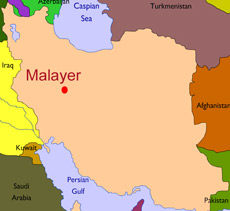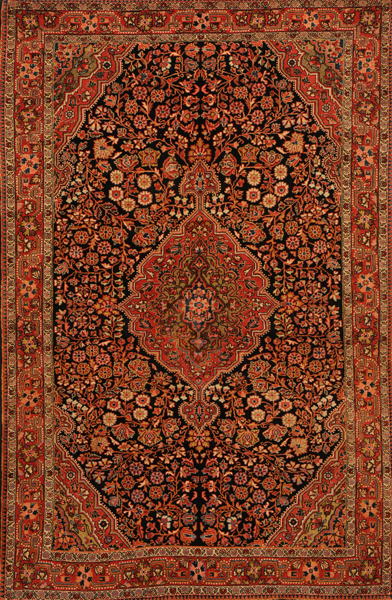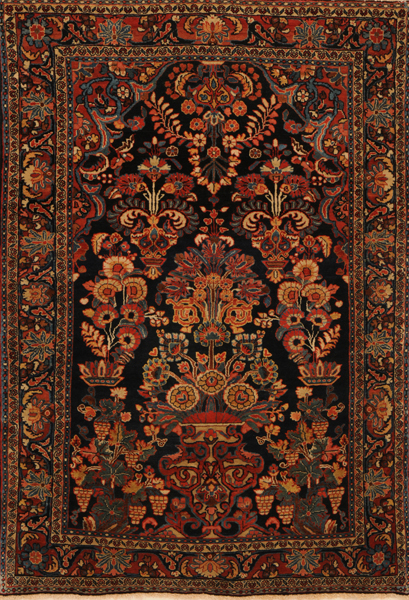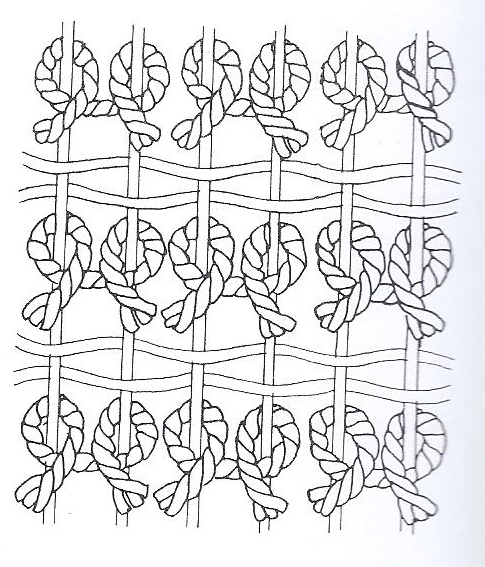Malayer
Malayer Rugs
Where Did The Malayer Rug Come From?
Hand-Knotted Malayer rugs are produced in Malayer, a large village between Hamadan’s major weaving areas and Sarouk in Northwest Persia.
One of over 100 weaving villages scattered around this region, Malayer has a long history in Persian rug weaving.

In the 19th and 20th centuries, production in Malayer and the surrounding smaller villages was almost exclusively limited to small-sized rugs runners woven by individual weavers. Very few families in the larger villages undertook the weaving of large rugs.
Table of Contents
Hand-Knotted Malayer Rugs: A Combination Of Two Distinct Weaving Styles
There are two distinct types of Malayer rugs.
Malayer Rugs Similar To Sarouk Rugs
Malayer weavers weave these in the south-east of Malayer. They are similar to Sarouk rugs in that they are double-weft with two cotton wefts and have a depressed cotton warp.
However, they have a few features that help tell them apart from others. Malayer weavers use the Turkish symmetrical knot, unlike the Persian asymmetric knot used to create Sarouks. Malayer rugs have elaborate scrolling vine borders and all-over medallion, relatively rectangular fields. These designs are not seen in Sarouks.
Malayer Rugs Similar To Hamadan Rugs
Malayer weavers weave this northwest of Malayer. They use Turkish symmetric knots and single-welted construction similar to Hamadan rugs.
However, the Malayer rugs have a much finer weave, which helps to tell them apart from their Hamadan counterparts.
Antique Malayer Rugs
Antique Malayer rugs have a rich history and are highly sought after by collectors and enthusiasts alike. Originating from the Malayer region in western Iran, these rugs are renowned for their exceptional craftsmanship, designs, and enduring beauty.
Antique Malayer rugs stand out due to their high-quality materials, such as fine wool and natural dyes that age gracefully, developing a rich patina. The weavers of antique Malayer rugs draw inspiration from their surroundings, creating captivating designs with motifs like florals, geometric shapes, and intricate medallions. These rugs feature a vibrant color palette, dominated by deep, rich hues of crimson, indigo, gold, and earth tones, making them a focal point in any room.
Antique Persian rugs are unique masterpieces, handwoven by skilled artisans who infuse creativity and cultural heritage into every piece. Collecting these rugs allows one to appreciate the artistic expression and cultural significance embedded in each creation. The rarity, beauty, and craftsmanship of an antique Malayer rug make them valuable investments that can appreciate over time, becoming cherished heirlooms.
In addition to their investment value, antique Malayer rugs offer practical benefits. Their durability makes them suitable for high-traffic areas and formal settings, while their woolen construction provides insulation and sound absorption, enhancing comfort and ambiance in any space. With proper care, these antique Malayer rugs can retain their allure and become treasured additions to your home for generations.

Malayer Persian Rugs: A Fusion of Creativity and Tradition
Malayer rugs are unique because the weavers combine the styles of their neighbors while still making something different. Each Malayer rug is unique and stands out.
The weavers borrow designs from nearby regions but add their ideas, which you can see in the final product. These rugs are some of the most beautiful village weavings from Persia.
In trade, people often call them ‘Hamadan Senneh’ rugs because they have elements of both styles. They have the delicate weaving of Hamadan rugs and the symmetrical Herati design of Senneh rugs.
Malayer weavers mostly make rugs with a single layer, but they are even finer than the original Hamadan rugs.
Foundation and Pile of Malayer Persian Rugs Woven
Both the South East and North West regions of Malayer utilize cotton warps and wefts in crafting the foundation of their rugs. However, there is a slight variation between the two.
In SE Malayer Rugs, the warp is slightly depressed, and a double cotton weft, often dyed blue akin to Sarouk rugs, is employed. This technique gives the rugs a unique texture and contributes to their resilience. On the other hand, the NW Malayer rugs feature a flat warp with no depression and a single cotton weft. These subtle differences in the foundation construction add to each region’s distinctive characteristics of Malayer rugs.
Regardless of the regional variation, all Malayer rugs share a common feature—a short wool pile. The deliberate choice to cut the pile short serves a specific purpose: to enhance the clarity and prominence of the intricate designs. By keeping the pile short, the weavers ensure that every detail of the motifs, patterns, and color combinations is accurately showcased. This meticulous approach to pile height creates a visually stunning rug where every element stands out with utmost clarity.
The combination of a sturdy cotton foundation and a carefully trimmed wool pile defines the craftsmanship and aesthetic appeal of Malayer rugs. Cotton materials enhance the rug’s durability, allowing it to withstand the test of time. Meanwhile, the short pile highlights artistic intricacies and contributes to the ease of maintenance.
Colors of Persian Malayer Rugs and Runners
One of the striking aspects of Malayer Persian rugs is their diverse color palette. From warm earthy tones to rich jewel-like hues, these rugs encompass a broad spectrum of shades that evoke a sense of warmth, elegance, and liveliness.
The weavers of Malayer draw inspiration from their region’s natural surroundings and cultural heritage, infusing their rugs with colors that reflect their environment. The earthy tones of terracotta, sandy beige, and warm brown embody the rugged landscapes, while deep blues and vibrant greens pay homage to the lush flora and serene skies.
Intricate patterns and motifs are brought to life through a harmonious combination of contrasting and complementary colors. Delicate flowers, geometric shapes, and intricate medallions are meticulously woven with threads of varying hues, creating a mesmerizing visual effect.
The use of natural dyes is another distinctive feature of Malayer rugs. Skilled artisans employ traditional dyeing techniques, utilizing natural ingredients such as plants, roots, and insects to achieve an extensive range of colors. These natural dyes lend a unique character to the rugs, adding depth and nuance to their overall appearance.
Design & Patterns of Malayer Carpets

Malayer rugs are renowned for their captivating mix of abstract and geometric motifs. These exquisite hand-knotted creations showcase various designs, from stylized vines and intricate lattice patterns to diamond-shaped or hexagonal medallions and timeless allover patterns.
The regional variations within Malayer rugs add further intrigue to their motifs. In Southeast Malayer rugs, it is more common to find medallions with corners, while in Northwest Malayer rugs, medallions and Boteh motifs adorn a Herati field, creating a distinct aesthetic.
Among the weavers’ favorite motifs is the Boteh, which symbolizes a sprouting seed. This motif is lavishly woven into their creations, sometimes covering entire fields in smaller rugs and runners. The repeated pattern, combined with the vibrant colors, creates a mesmerizing effect that enchants the viewer.
Weaving Techniques Used in Malayer Rugs
Malayer rugs, regardless of their type, are woven using the Ghiordes or Turkish symmetric knot. This distinctive knotting technique is believed to have been influenced by the Turkish heritage of many of the weavers. The Ghiordes knot involves looping the weft thread around pairs of warp threads, resulting in a symmetrically tied knot that holds the pile firmly in place.
The choice of the Ghiordes knot, combined with a robust cotton warp and weft, contributes significantly to the renowned durability of Malayer rugs. The strong cotton foundation ensures structural integrity and resistance to wear, allowing these rugs to withstand the test of time and foot traffic.
The Turkish knot’s tight and secure nature ensures that the rug pile remains firmly anchored, preventing shedding and enhancing its ability to retain its original beauty for years. This meticulous knotting technique passed down through generations, exemplifies the commitment to craftsmanship and attention to detail that defines Malayer rugs.
The combination of a sturdy foundation and the Turkish symmetric knot makes Malayer rugs visually captivating and highly functional. They are well-suited for both decorative purposes and everyday use, with the ability to withstand the demands of busy households and high-traffic areas.

Typical Sizes of Malayer Rugs
Malayer rugs can be found in a wide range of sizes, from smaller rugs measuring 2’x3′ to larger rugs measuring 4’x7′. You can find these rugs in several other variations besides the dimensions mentioned. However, oversize Malayer rugs are pretty rare as these were usually only made on commission.
Care Tips for Preserving the Beauty of Your Malayer Rug
Owning a beautiful Malayer rug is a privilege, and to ensure its beauty lasts for generations, it’s essential to provide the proper care and maintenance. Here are some valuable tips to help you preserve the allure and quality of your cherished Malayer rug:
Regular Vacuuming
Vacuum your rug regularly to remove dust and debris. Use a low-power setting or a vacuum cleaner with adjustable suction to avoid pulling or damaging the fibers. Gently pass the vacuum over the rug in the direction of the pile, both horizontally and vertically, to ensure a thorough cleaning.
Rotate for Even Wear
To promote even wear and prevent specific areas from experiencing excessive traffic, rotate your Malayer rug periodically. This simple practice helps distribute foot traffic and sunlight exposure, allowing your rug to age gracefully and maintain its beauty.
Protect from Sunlight
Prolonged exposure to direct sunlight can cause fading and deterioration of the rug’s colors over time. Place your Malayer rug away from intense sunlight or use window treatments, such as blinds or curtains, to shield it from harmful UV rays. This precaution will help preserve the rug’s vibrant hues for years.
Use Rug Pads
Placing a rug pad beneath your Malayer rug provides an extra layer of protection. Rug pads prevent slipping and tripping hazards and reduce friction between the rug and the floor, minimizing wear and tear. Additionally, they promote air circulation, which helps prevent moisture buildup and potential damage.
Clean Spills Immediately
Accidents happen, but it’s crucial to address spills promptly. Blot the affected area with a clean, white cloth or paper towel to absorb as much liquid as possible. Avoid rubbing or scrubbing, which may push the stain deeper into the fibers. For stubborn stains, consult a professional rug cleaner to ensure proper removal without causing damage.
Professional Cleaning
Every few years, consider having your Malayer rug professionally cleaned by experts experienced in handling delicate textiles. Professional cleaning helps remove deeply embedded dirt, revitalizes colors, and rejuvenates the rug’s overall appearance. Always choose reputable rug cleaning services specializing in hand-knotted rugs to ensure the utmost care.
Avoid DIY Repairs
If your Malayer rug requires repairs, such as fringe restoration or fixing loose threads, it’s best to consult a professional rug repair specialist. Attempting DIY repairs without proper knowledge or expertise may lead to irreversible damage. Trust the skills of professionals who can skillfully restore your rug’s integrity and beauty.
By following these care tips, you can ensure that your treasured Malayer rug remains a focal point of beauty and admiration in your home. With proper maintenance, it will continue to tell the story of its rich heritage and captivate future generations.